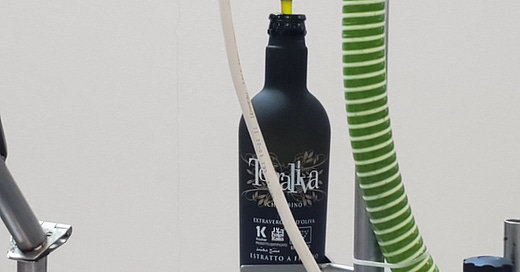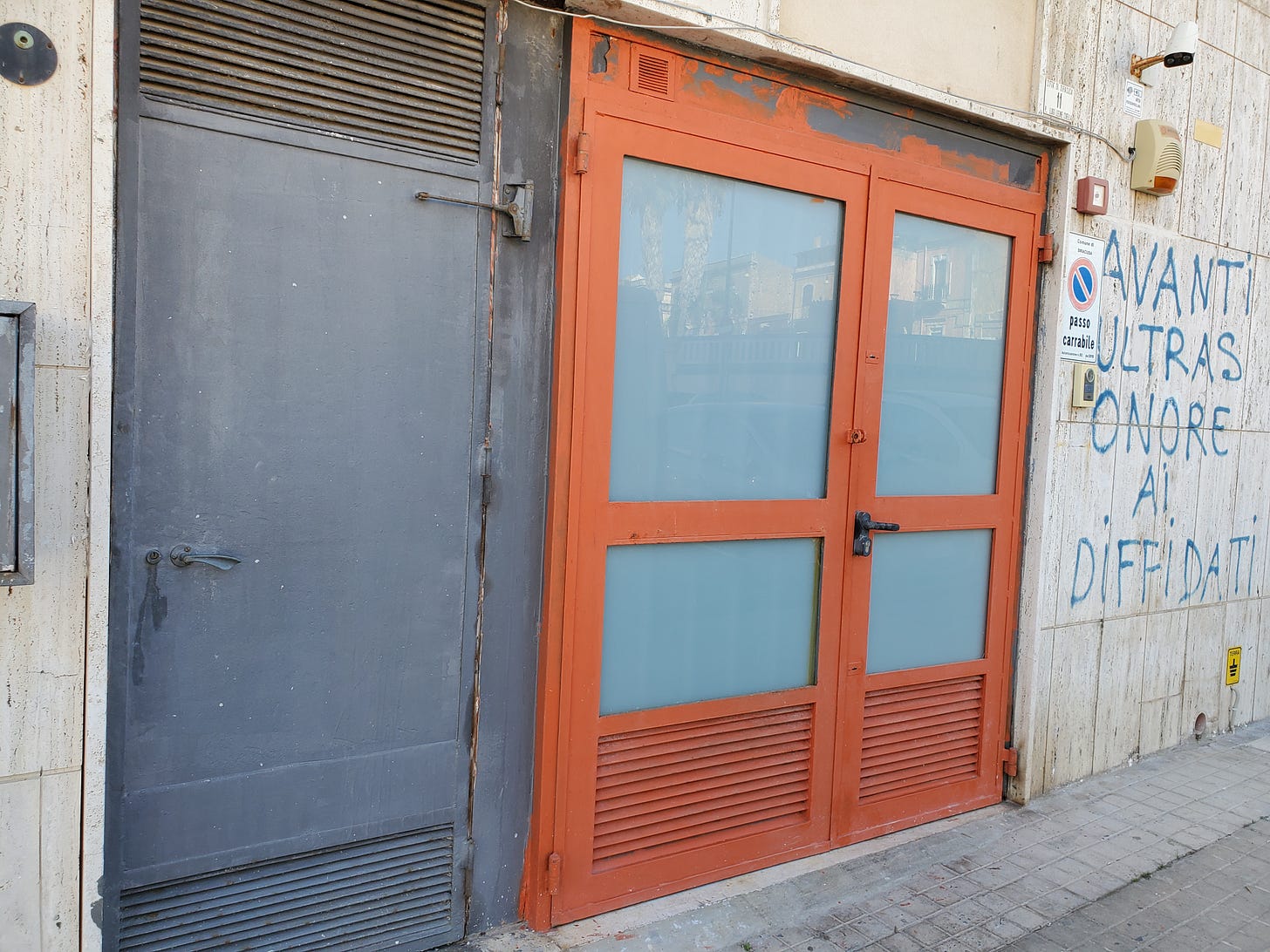One thing my wife and I wanted to do in Sicily was visit some kind of olive oil farm/production facility/tasting room. Just like you have winery tours and tastings, we wanted to do that with olive oil.
As you might know if you’ve read this newsletter for awhile, I love to cook, and yes, I make a lot of Italian food. Good olive oil is a must, and in America it often costs a pretty penny. If you buy direct like this in Europe, it’s a lot cheaper. First, of course, you have to be in Europe.
It wasn’t too easy to find such a place, at least not in proximity to any of the towns and cities we stayed in. But in Siracusa, we found one lead on Google Maps. The map showed an olive oil store as being on a kind of drab industrial block; the reviews suggested that it might not be a public-facing spot, or that it might not be there anymore. A reply from the owner promised that it was.
A little side note: a lot of the Google info about places, especially the hours, was pretty useless in Sicily. I’m not sure why: hours seem to be sort of ad hoc, and maybe business owners don’t update Google themselves. A lot of the information is probably crowdsourced or outdated.
But the phone number worked, and so we gave this possible olive oil store/facility a call. A man with some basic English proficiency picked up. I asked if it was possible to visit the place and taste olive oil tomorrow morning. These conversations, of which we had a few on this trip, are short. Either the question is understood, or not. No point asking clarifying or asking follow-up questions or trying to make some kind of jokes or small talk.
“Yes. Sure. 10?” “Yes. See you tomorrow!”
So we were going.
Sometimes it’s a good sign when you arrive somewhere and you look around and say, “Are we at the right place?” Unassuming hole-in-the-wall and all that. But there was no signage that we could see (there was an address marker—it was tiny, and Google had us half a block away). So we called again, and the same man picked up and told us he’d be right out to show us the entrance.
A couple of minutes later, a young woman came out, waved at us, and asked us if we were here for the olive oil. “You sound different in person,” I almost said. (I also almost said something about being on the Axis side when we had to do a bomb-shelter simulation at the World War II museum in Catania. There’s a reason I almost say a lot of things.)
Pre-empting my joke, she explained she was the daughter of the man we’d spoken to, and the two of them work at the production facility. It was just through a large door, with a small, plain sign above.
Inside were tile floors and machinery. This was not a tasting room or a store; it was a bottling facility, and in between the work of running the olive oil packing business it was possible to schedule a tasting.
They also had olive groves, a bit away from the city, and crushing equipment elsewhere. But here, the oil was delivered, stored in cool tanks, and bottled and packed for shipping.
We chatted while we tasted. Where can you buy it? Well, one store in America sells it: a wine shop in Wheeling, West Virginia! You can ship to America too, but we just tightly packed a couple of bottles in our luggage.
The tasting was simple: a few pieces of bread and just one kind of oil. That was the only one they had, and it was made from a single kind of olive—in wine, what’s called a single-varietal wine, as opposed to a blend. A lot of olive oil is also blended, sometimes for elevating or complementing different characteristics (good), and sometimes for concealing defects (bad).
This was very good olive oil. As far as we were able to tell, from this and the handful of oils we had in restaurants, Sicilian olive oil is mild and rich. Some call it “buttery.” My wife and I personally prefer olive oils with grassy, spicy, slightly bitter flavor notes—the olive oil we had in Croatia was like this, and it was so good we buy it online and pay the premium (from these guys). But that’s just a matter of taste. You can tell, especially side by side, the difference between a name-brand supermarket olive oil and one like this.
We bought the two bottles, which were about $20 a piece: expensive compared to a lot of supermarket options, but very fair for the quality. You cannot buy that much excellent olive oil in America for $20.
And you cannot have it bottled to order either:
Here’s the bottling area:
And the tanks:
I was not expecting our bottles to be filled, and even labeled, on the spot! This was one of the coolest things we did in Sicily. My parents went to Vermont a few times in the early 1990s, and they went to a microbrewery and a cheesemaker’s shop. This was before these things were super-trendy. You would actually meet the owner/maker and talk with them, and the visiting experience was informal and social. This reminded me of that.
It’s rare you still get that kind of experience today. It’s so cool when folks who make things take some time to share them, and when it hasn’t been formalized into some kind of fancy, expensive “curated” “experience.” For that, see the tour and tasting options at any Napa Valley winery, for example.
Or, uh, the other olive oil facility we visited…To be continued.
Related Reading:
Thank you for reading! Please consider upgrading to a paid subscription to help support this newsletter. You’ll get a weekly subscribers-only piece, plus full access to the archive: over 800 pieces and growing. And you’ll help ensure more like this!











I also love Italian cooking, but I’m not a fan of olive oil. I add a French/English/American twist to most of my Italian cooking by prioritizing butter. I think butter has a much better flavor and is actually less calorically dense by weight. 15g of olive oil is 95% or more fat, while the same weight of butter is 80%.
That said I did just make garlic confit for the first time for Thanksgiving and it not only led to the best garlic bread I’ve ever had, but also left me with a large amount of very delicious garlic-infused olive oil, which I now use with more relish than the normal stuff.